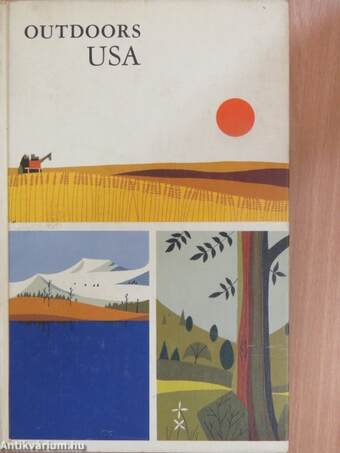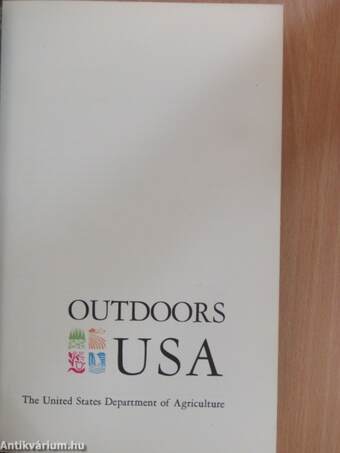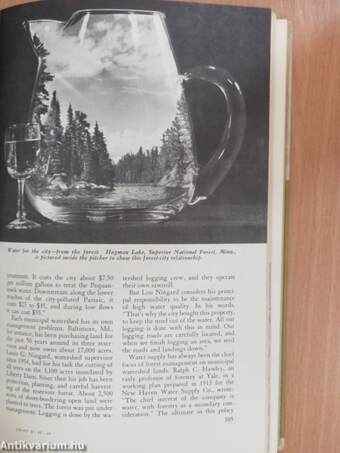1.068.232
kiadvánnyal nyújtjuk Magyarország legnagyobb antikvár könyv-kínálatát

VISSZA
A TETEJÉRE
JAVASLATOKÉszre-
vételek
Outdoors USA - The Yearbook of Agriculture 1967
| Kiadó: | The United States Department of Agriculture |
|---|---|
| Kiadás helye: | |
| Kiadás éve: | |
| Kötés típusa: | Fűzött keménykötés |
| Oldalszám: | 408 oldal |
| Sorozatcím: | The Yearbook of Agriculture |
| Kötetszám: | |
| Nyelv: | Angol |
| Méret: | 24 cm x 16 cm |
| ISBN: | |
| Megjegyzés: | Számos fekete-fehér fotóval, illusztrációval, néhány színes fotóval. |
naponta értesítjük a beérkező friss
kiadványokról
naponta értesítjük a beérkező friss
kiadványokról
Fülszöveg
A mountaintop symbolizes man's goals, aspirations, and yearnings for the "better life."
A mountaintop symbolizes also the spirit of our 1967 Yearbook and its authors; and the spirit of the Department which I head.
A mountaintop symbolizes conservation.
From the mountaintop, we have a sweeping view of man's total environment— an environment we share with all other living things.
From the valleys below, where our food and clothing are produced, we lift our eyes across tilled fields and green pastures and the timbered slopes that provide shelter for the wild creatures and wood for human creatures to the snowcapped mountain that helps to water the valleys in the heat of summer.
About half of the U.S. Department of Agriculture's staff works in some phase of conservation to preserve the scenic splendor of our mountaintops and our other natural resources, while getting the most use from them. These 50,000 USDA'ers are busy helping to develop our forests and wood sources; helping to... Tovább
Fülszöveg
A mountaintop symbolizes man's goals, aspirations, and yearnings for the "better life."
A mountaintop symbolizes also the spirit of our 1967 Yearbook and its authors; and the spirit of the Department which I head.
A mountaintop symbolizes conservation.
From the mountaintop, we have a sweeping view of man's total environment— an environment we share with all other living things.
From the valleys below, where our food and clothing are produced, we lift our eyes across tilled fields and green pastures and the timbered slopes that provide shelter for the wild creatures and wood for human creatures to the snowcapped mountain that helps to water the valleys in the heat of summer.
About half of the U.S. Department of Agriculture's staff works in some phase of conservation to preserve the scenic splendor of our mountaintops and our other natural resources, while getting the most use from them. These 50,000 USDA'ers are busy helping to develop our forests and wood sources; helping to develop watersheds and river basins, fish-stocked lakes, and ponds for swimming and boating as well as storing water; helping to develop farms that besides growing crops offer good hunting, fishing, and other recreation.
The scope of these activities is amazingly wide. USDA conservation programs can benefit some 81 percent of the Nation's total land: all the Nation's cropland, grassland, pasture, and range, the vast national forests and national grasslands, and much of the private forest land.
Our conservation responsibilities require us to operate the world's largest outdoor playground—the 186 million acres of the national forests and the national grasslands. This year that "playground" will provide around 153 million visitor days of use for recreation purposes. These forests—your forests—have more than 7,000 camp and picnic grounds, able to accommodate half a million people at a time. Nearly 200 winter sports areas, financed privately and operated under paid permits, can simultaneously accommodate 300,000 persons.
In fulfilling another part of our conservation responsibilities in the national forests, we harvest more timber than the biggest lumber company in the world. Last year's harvest was valued at nearly $200 million. This harvest, by private industry, provides not only homes for America, but raw material for newspapers, furniture, and countless other industrial products as well. Vissza
Témakörök
- Természettudomány > Növényvilág > Nemzeti parkok, arborétumok
- Idegennyelv > Idegennyelvű könyvek > Angol > Egyéb
- Idegennyelv > Idegennyelvű könyvek > Angol > Természettudományok > Egyéb
- Idegennyelv > Idegennyelvű könyvek > Angol > Évkönyvek, kalendáriumok
- Évkönyvek, kalendáriumok > Évszám szerint > 1961-1970
- Évkönyvek, kalendáriumok > Témakör szerint > Idegennyelvű
- Évkönyvek, kalendáriumok > Témakör szerint > Természettudományok
- Évkönyvek, kalendáriumok > Témakör szerint > Mezőgazdaság
- Sport > Egyéb sportágak > Természetjárás
- Mezőgazdaság > Erdőgazdálkodás > Egyéb
- Mezőgazdaság > Mezőgazdaság általában > Agrárgazdaság
- Természettudomány > Növényvilág > Természetvédelem
- Mezőgazdaság > Egyéb
- Idegennyelv > Idegennyelvű könyvek > Angol > Sport > Egyéb
Megvásárolható példányok
Nincs megvásárolható példány
A könyv összes megrendelhető példánya elfogyott. Ha kívánja, előjegyezheti a könyvet, és amint a könyv egy újabb példánya elérhető lesz, értesítjük.








